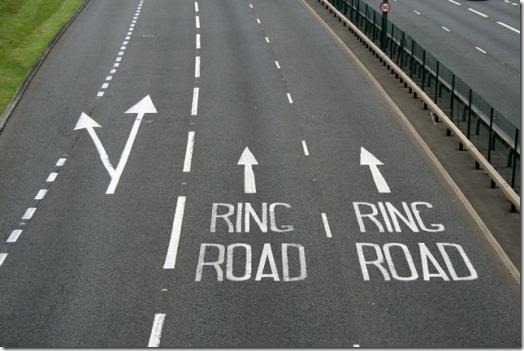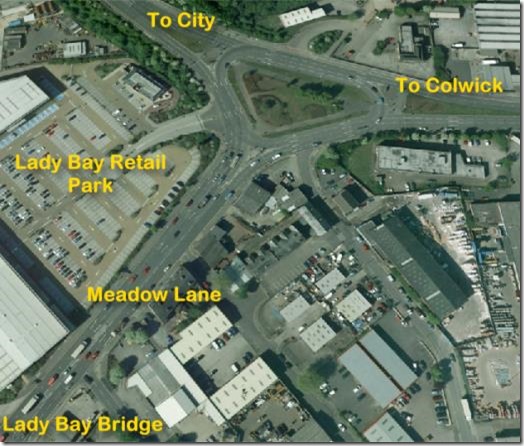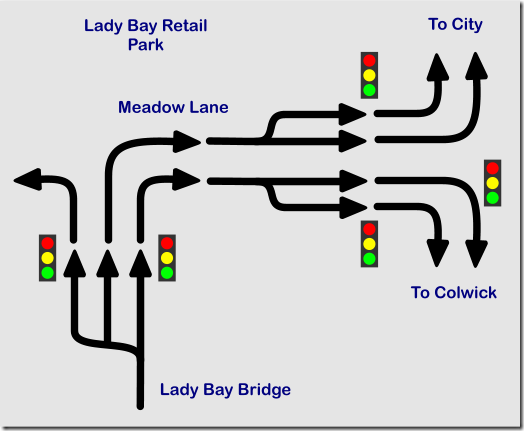I originally wrote about this back in 2011 as a result of people asking which lane they should choose at traffic lights and how they should merge back in later on. But there is a lot more to the topic than just traffic lights – it applies to junctions, roundabouts, and normal driving.
Not choosing the correct lane and not staying in lane is one of the most common causes of driving test failure. It is marked on the DL25 Driving Test Report under section 23, Positioning, and the ticks can go in either the normal driving or lane discipline boxes depending on what has happened. Furthermore, not staying in lane can lead to faults for observation and mirror checks. You just have to face the fact that poor lane discipline – whether through bad decisions or simply not realising you’re doing it – means that you’re unlikely to be checking what’s happening behind you. This is especially true at roundabouts and complex junctions with multiple lanes, where you will be concentrating on what’s in front.

The reasons why people abuse lanes are many and varied, and run all the way from deliberate arrogance through to blind panic as a result of not knowing the correct procedure to start with, There’s not much anyone can do to help you sort out your driving behaviour if you’re an evil little chav (or an Audi or taxi driver) who simply has to get in front of as many people as possible before cutting into a small space just before your turn. But if it is just a result of not understanding then there is a lot you can do to fix things.
Satellite Images – You can zoom into any roundabout or junction using Google Maps or Google Earth in the comfort of your own home. If you know what you are looking for (and at – many people are as bad at interpreting aerial maps as they are at choosing lanes), and can translate this into the ground level view, you can work out how lanes work at junctions and roundabouts. With Google Earth, roundabouts in many big cities can be “driven through” at ground level using your mouse scroll wheel.
Detailed Diagrams – Driving instructors often have access to roundabout diagrams, and these can be useful for explaining the basics. However, most diagrams are generic and don’t accurately represent actual layouts of many real world roundabouts. If you search hard enough, you might come across detailed blueprints taken from council highways department archives, and these can help if you are able to strip away the complexity.
Arrow Diagrams – Driving instructors ought to know how all the local roundabouts work in fine detail. One way they can help you understand the flow is by converting the aerial view into an arrow diagram. Take this example of a roundabout system close to the Colwick Test Centre in Nottingham. This is the satellite view taken from Google Earth.

You can pick out the lane markings quite easily when you zoom in, but because of the overall scale you can’t get a single-page printout which shows all the detail.
Here’s the same roundabout system showing the route from Lady Bay Bridge at the lower left of the aerial image, along Meadow Lane, and either turning left towards the city centre or right towards Colwick (and the Test Centre).

It’s not intended to be to scale. It is only intended to show lane layouts.
Lane Discipline
Using this diagram, if your intended route from Lady Bay Bridge was towards the city centre, your lane choice (i.e. “discipline”) should ideally be as shown by the green dots below. If you automatically followed the route shown by yellow dots without thinking then you would be exhibiting poor lane discipline.

There are several reasons why you might correctly choose the yellow route (e.g. heavy traffic in the left lane, or planning to turn right further on), but it is not the default choice.
Lane Discipline at Traffic Lights
At traffic lights you often find that the road splits into two lanes, then merges back into one just after. This happens where there is a junction, and it’s purpose is to prevent people being held up by those who are turning. It is effectively an overtaking lane meant to keep traffic flowing.
Under normal circumstances you should stay in the left hand lane. If you know what you are doing you can overtake in the right hand lane, but you must be able to confidently handle the merge back on the other side. For a learner on their driving test, that could be either a huge bag of brownie points if they get it right, or a serious fault (and fail) if they don’t.
Remember that at a crossroads, as well as people turning left there may be others turning right, so if you move into the right hand lane you could get stuck behind those waiting for a gap in the traffic. Annoyingly, many people wait right until they have stopped in the middle of the junction before signalling, so you have got to be careful. Never assume that the right hand lane is the “fast” lane. It usually isn’t – something the Audi drivers and boy racers never seem to learn, and if you have remained in the left hand lane be ready for these trying to cut back in again.
What is meant by “lane discipline”?
It means choosing the correct lane at the appropriate time and – to a certain extent – staying in that lane.
If road markings or road signs indicate which lanes to use to head off in certain directions and you wait until the last moment to change, then you are guilty of poor lane discipline. If you straddle lanes or wander out of your own lane then you are also guilty. You could also be marked for poor planning, normal driving position, observation/safety (if you don’t realise you’re doing it), response to traffic signs/markings, and so on.